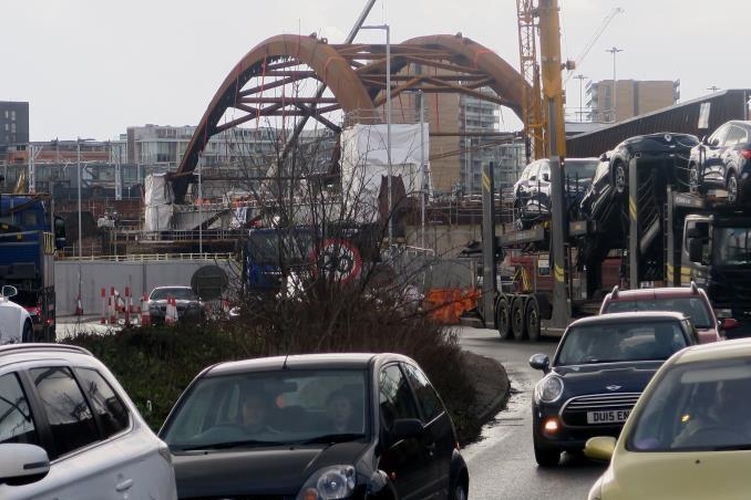Jonathan Schofield on central Manchester's best architectural work of the last decade
There is a huge amount of really good work from the last ten years in the central areas of Manchester and Salford. Some big, some small, and much of it by designers based here. Some of the work is inspirational, lifting the spirits as you pass. Some is deft, fitting the city scene like one brick placed next to another.
Of course, this being 2017 the good new work often takes place within the context of the old. Refurbishment, reconstruction and restoration of old buildings is part of the story, one that the Victorians and the Georgians - our dear ancestors and the authors of much of our beloved past - would scarcely understand.
Now we are wiser (no, we really are) and see that variety is the spice of life, we also need the old structures to give us context and identity. Not that we should ever be stuck like butterflies on a pin over conservation like a York or a Cambridge. Dynamic cities change shape, morph, become something different and better if we are lucky. We have been fortunate over the last two decades to see the central areas blossom and become immeasurably better visually then they were back then.
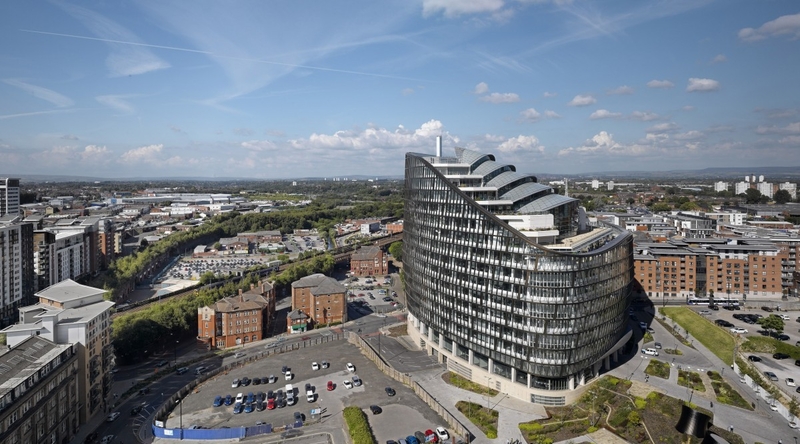
Here we can only choose one building in every category so inevitably some cracking schemes have missed out on this list. For instance, in the large commercial category the Co-op’s One Angel Square was in competition with One St Peter’s Square, but came second because it still feels isolated and remote from the cityscape around it, whereas One St Peter’s Square plays a glorious role in making St Peter’s Square a success.
This week we look at civic, commercial, residential and transport projects. Next week we’ll post Part Two, looking at the best hotel, best university, educational, performance and cultural spaces together with a few wildcards.
Civic building restoration project
Central Library and the Town Hall Extension - 2014 - Ryder Architecture (Library) and SimpsonHaugh and Partners (Town Hall Extension)
These two practices have given the city back two of its greatest buildings, originally designed by Vincent Harris and constructed in the 1930s. Central Library is a marvel in its refurbishment, not only because it looks beautiful externally and works superbly internally, but because it is hugely popular. Around 1.4 million people use the library each year. That is proof of the pudding for any public building. The engineering of the mighty new stairs and lifts by Laing O'Rourke is breath-taking and worth a look in its own right. Meanwhile the restored elements including the main reading room (now called the Wolfson Reading Room) and the Shakespeare Hall look simply beautiful. Ryder have delivered us a building better than the original.
The same could be said of the Town Hall Extension by SimpsonHaugh, although less of this large building can be viewed by the general public. Still the restoration of the Rates Hall is a total triumph, a grand statement of civic intent given back to Manchester, an example of how cities should aspire to deliver quality and build a civic identity. If you get chance a trip to the Council Chamber and its ante-room is recommended. The planning by the architects and the engineering by Laing O’Rourke to fit part of the library into the basement and the ground floor range facing St Peter’s Square is incredibly cunning.
New civic building
The Civil Justice Centre - 2007 - Denton Corker Marshall
This is a building that delivers the killer visual punch. Australian architects Denton Corker Marshall have delivered for the city a building bold in form and striking in silhouette. It’s also a monster; 81m (266ft) tall on 15 levels over 34,000sqm with 47 courtrooms (Technical, Family, County, Civil and High), 4 tribunal courts, 75 consultation rooms plus office and support space. It’s the biggest court complex to be built in the UK since the Royal Courts of Justice in London of 1882. The most eye-catching parts externally are the protruding glass rooms floating one over the other and the huge glass wall on the west. This is a ‘stage for the performance of the heaven’ (to quote Ted Hughes) reflecting the city back on itself. Catch it at sunset.
Commercial development - large
One St Peter’s Square - 2014 - Glen Howells Architects
This looks top quality and feels top quality from all angles. It is a powerful, unashamed example of commercial verve and muscle and one of Manchester's most successful additions to the cityscape for a generation. One St Peter's Square pays respect to Central Library and the Town Hall Extension (see above) but introduces a visually exciting, very clean and very contemporary presence of its own. The exciting atrium adds to this, but it’s the clever external curve on the western side leading the eye down Oxford Street or into St Peter’s Square which reveals that extra attention to detail. The style is almost a modern version of the Classical architecture of the library opposite. There’s other alchemy - despite its height at 60m (200ft) - as it no way overshadows those older landmarks in the square, instead it just makes the whole place much better.
Commercial development - small
Swan Square - 2012 - q2 architects
Not everything has to be statement architecture, in fact most new buildings shouldn’t be unless intended as landmarks (unless they have the budget). The three storey building of fourteen workshops from q2 architects at the junction of Swan Street and Hilton Street is exemplary in the way it fits with the scale of the older buildings around this area, reintroducing unbroken terraces in a concise, precise and yet very modern manner. The Staffordshire brick colour of blue-grey gives the building real presence, underlining how this is architecture with the grace to defer to its location yet make itself felt. The building also plays a fine game of creating a strong city centre mood as every unit has its own shop front. The Royal Institute of British Architects (RIBA) hit the nail on the head when they said: ‘Certain buildings set about their work with self-assured, quiet dignity. Swan Square is one of those. This well-considered series of three-storey start-up units is the perfect example of how to re-establish and invigorate an unloved and forgotten area of the city’s fabric.’
You may also like: Manchester's ugliest new buildings
New residential development - large
One Greengate - 2016/17 - OMI
This is a chalk and cheese mega-building. Some people think it is too big and too bulky, Confidential says they just have fear of large. In the old centre of Salford, adjacent to where Salford Cross used to stand and where a public park is planned, OMI architects have spun into place four large structures that make one big bounteous scheme of 500 apartments from 10 storeys to 31 storeys (88m, 288ft, almost exactly as tall as Manchester Town Hall tower). As we’ve written before, One Greengate is a considered and carefully crafted proposal, with clarity of design when it comes to the use of massing, optimisation of light and space for the apartments. On cleared ground this scheme doesn’t try to talk to the past (even though the dark brick elements might look a tad utilitarian) and nor should it. Instead it is forthright and positive reboot for the area with a decent profile at the cap, good communal areas and even room for a riverside walk.
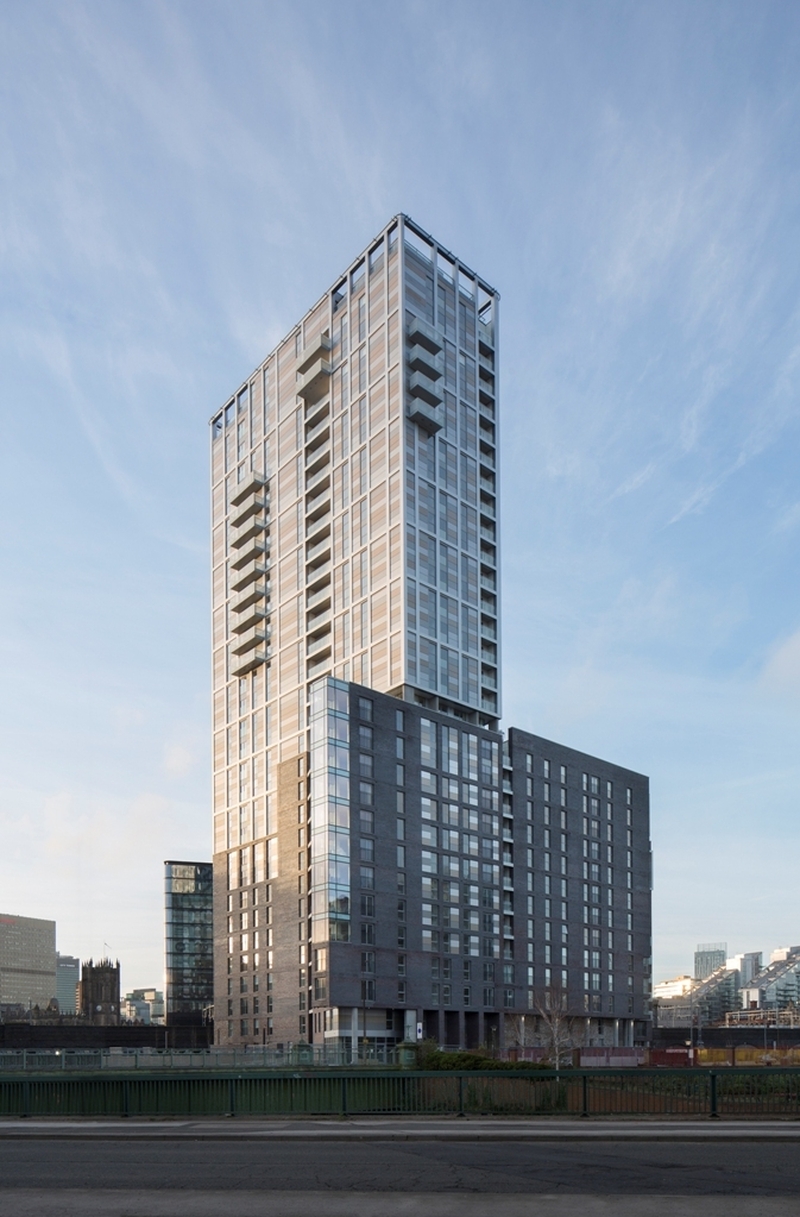
New residential development - small
Timekeepers Square - 2016/17 - Buttress Architects
As with the q2 offices this lovely development is all about subtle understatement combined with handsome presentation and relevance to the site. It is above all a thoughtful development. It pays heed to its location in an area that was distinguished by Georgian townhouses - some of which survive round the corner in Encombe Place - while creating a sweet avenue to the strong architecture of St Phillip’s Church from 1824 by Robert Smirke (also architect of the British Museum). The name of the development comes from the clocks on St Phillips. The publicity has called the houses ‘Georgian’ but that misrepresents these 36 dwellings of two, three and four bedrooms with their balconies and lovely attention to detail, as they are thoroughly modern. The choice of brick produces stone-like textures that talk not only to St Phillip’s but also the Roman Catholic Cathedral of St John’s a little further to the east. The development brings out the best in Andrew McKeown's 100 times larger than life 'sycamore seed' sculpture as well. For the record the brick type is called a Smoked Branco Wienerberger. No really. Gordo of Confidential is convinced he thoroughly enjoyed one of those at the Christmas Markets. Joshing aside, for once in the world of architecture Timekeepers Square looks better than the CGIs before they were built. That is a real achievement.
Transport restoration project
Victoria Station - 2015 - BDP
What dominates and drags the eye away from anything else in the Victoria Station restoration is the mighty new roof as it swoops in from the east and then swivels to the north. This really is a thing of wonder. Catch it down Hanover Street from Shudehill and you stop in the street and stare. Between buildings, at the bottom of the street, is a naturalistic form that appears to have attached itself like an exotic plant or centipede to the station. The stats are impressive, for instance, the largest of the steel ribs is 100m long and weighs almost 70 tonnes. The panels between the roof ribs are filled with ETFE (ethylene tetrafluoroethylene) panels, ‘a lighter and cheaper alternative to glass’, though we do wish the panels were glass. The glorious Edwardian areas have come up trumps in the project as well, especially the elaborate former dining areas of plaster, mosaic and tile. There are now two moving war memorials, one brand new. Aside from the awkward tracing of the old engine sheds against the main station block, Victoria Station indicates better times for the northern end of the city centre.
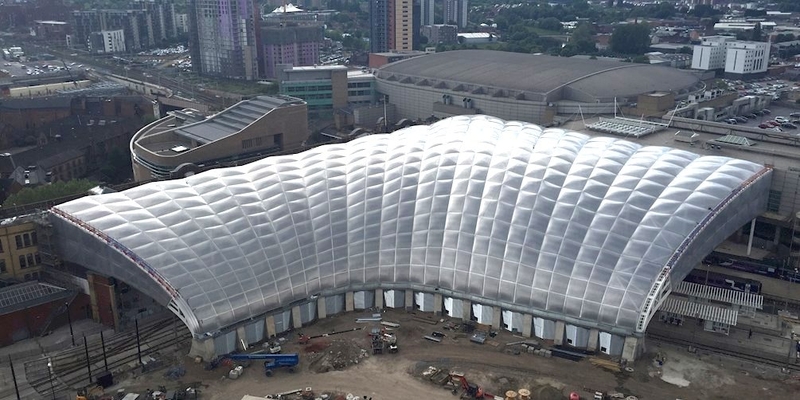
New infrastructure project - large
Ordsall Chord - Under construction - BDP and AECOM Mott MacDonald
Engineering and architecture come together to marvelous effect in this mammoth city centre civil engineering project which, might we say, is the biggest standalone such project since the construction of the Mancunian Way in 1967. As we’ve written before the steel element incorporating the viaduct over the River Irwell resembles a single elegant pen stroke from Japanese calligraphy. It’s a triumph; efficient, smart, and, because of that simple fitness for purpose, beautiful. The sections leading to the main viaduct on each side repay study too whilst the anticipated landscaping will lift the project even further. The sheer vigour and scale of the Ordsall Chord scheme is energising, aside from the positive boost it will give to rail transport by finally linking Piccadilly Station with Victoria Station. Its boldness even helps mask the heritage cost of losing the main line link with the oldest railway station in the world, the Liverpool Road Station in the Museum of Science and Industry.
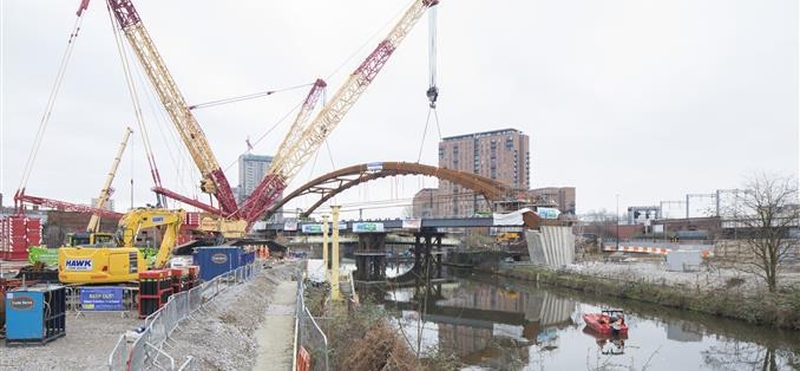
New infrastructure project - small
Deansgate-Castlefield Metrolink Station - 2015 - SimpsonHaugh Architects
This Metrolink station makes public transport a thing of joy. It allows a dreary 1980s footbridge to Deansgate rail station to shed its grubby, translucent, perspex carapace. It delivers two separate station platforms, two elegant staircases and a soaring lift shaft, then wraps them in green walls and sedum trackways adding birch trees for good measure. There are even two blocks of COR-TEN steel with various kit in them that fit the ensemble perfectly. Over an incredibly complex site Manchester has gained a thing of robust beauty combined with a friendly viewing platform of the southern part of the city. Architects often tell porky pies about responding to the location of their designs. This station feels the opposite of that and at the same time hits all the right notes in melding architecture and infrastructure with imaginative planting. Man and nature melded.





